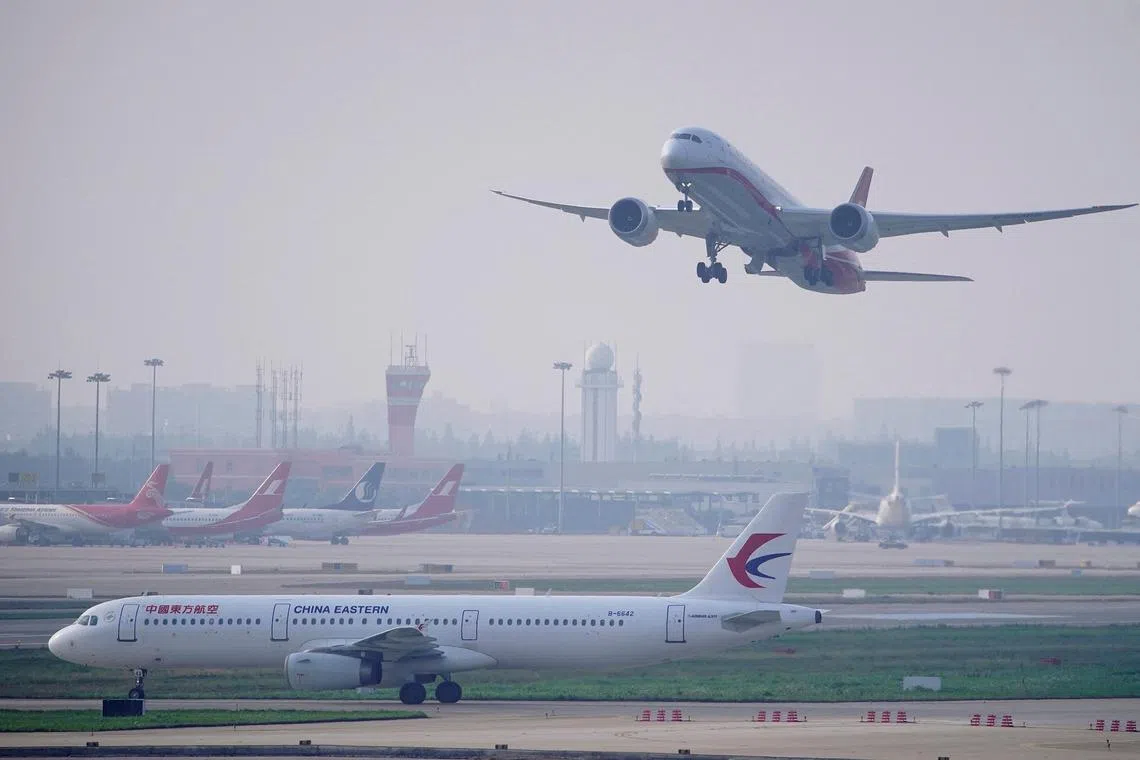Chinese New Year without China’s zero-Covid policy to put airlines to the test
Sign up now: Get insights on Asia's fast-moving developments

Scheduled inbound flights for the first quarter have increased almost 150 per cent compared with the first quarter of 2022.
PHOTO: REUTERS
Follow topic:
BEIJING – The weeklong Chinese New Year holiday, which kicks off on Sunday, will be a key test for China’s aviation sector. As millions of people travel home to be with their families – the first proper reunions since Covid-19 – the question is whether the same chaos seen at airports in other countries as they reopened will be replicated.
Endless queues, a lack of check-in staff and insufficient luggage handlers were common complaints worldwide once virus restrictions were lifted and people took to the skies. While there’s little evidence yet of that happening in China, mayhem could still ensue as big-city office workers – more likely to fly than catch a train – pack their bags.
“As North America and Europe opened up, passengers experienced significant disruptions as a consequence of resource constraints – a shortage of staff at airlines, customs, immigration and security,” said Mr Rob Morris, the global head of consultancy at Ascend by Cirium. “There’s a risk China might see the same if demand rebounds rapidly.”
Certainly the desire to travel is there. Flight bookings are up 15 per cent this Chinese New Year versus last, according to Trip.com, while scheduled inbound flights for the first quarter have increased almost 150 per cent compared with the first quarter of 2022, data from aviation analytics company Cirium show. And with nations from South Korea to Australia imposing restrictions on visitors from China, many expect international travel to rebound more slowly, putting additional strain on domestic networks.
“The willingness to travel has started to rebound strongly among Chinese who have recovered from Covid but it takes time for that to be reflected in outbound travel routes,” UBS Securities’ head of China leisure and transport research Chen Xin said. “Domestic travel destinations are expected to be the biggest beneficiaries during the upcoming Chinese New Year.”
The temporary mass migration comes as Chinese airlines only just start to get their Boeing 737 Max jets back into commercial service
One factor working in China’s favour is that unlike Western carriers, which grounded planes and furloughed staff at the start of the pandemic and then struggled to add capacity when travel came roaring back, airlines in China have largely continued to operate their fleets domestically throughout.
Avolon Holdings Chief Executive Officer Andy Cronin said earlier this week that carriers in Asia’s biggest economy should be able to cope well with any rapid demand rebound considering “they’ve got the people, they’ve got the infrastructure ready to go”.
Another element that may shield China’s aviation infrastructure from overload
Domestic passenger share at Shanghai Airport, China Southern Airlines and peers could fall below 3 per cent during the Chinese New Year travel season this year from almost 4 per cent in 2021-22, based on plans for seat capacity that’s equivalent to 73 per cent of 2019 levels. Railways should attract more passengers versus 2019’s Chinese New Year as travellers find a wider range of seat, fare and route options.
“Executives stuck outside the country for almost three years are keen to get back but they’re also going to be hesitant to put themselves or their teams in harm’s way if there is still any threat of unwarranted hospitalisation,” Mr Noah Fraser, managing director of the Canada China Business Council, said.
One pain point that may emerge – a lack of pilots.
Before the pandemic, the country’s burgeoning aviation market offered pilots some of the best-paid jobs in the world, with airlines so desperate for experienced flight crew that they were dangling packages worth more than US$300,000 (S$397,000)-a-year at foreign aviators. However after China shut international travel and imposed sweeping restrictions on movement, compensation packages for foreign pilots flying for Chinese airlines more than halved.
The reopening offers overseas pilots the chance to get back to work on the mainland and while packages aren’t as lucrative as they once were, some airlines are still paying top dollar.
Sichuan Airlines Group, for example, is offering US$24,441 a month for Airbus SE A330 captains on a three-year deal, and as much as US$27,841 a month if they renew the contract, according to a job ad on the website of pilot recruiter Wasinc International, which specialises in hiring for Chinese airlines.
Chengdu Airlines is willing to pay US$25,500 a month for three years for an A320 captain from overseas. The package climbs to US$28,600 for a second three-year term, according to Wasinc’s job ad.
“We’re hopeful we can finally get some of our pilots back to China,” Mr Dave Ross, Wasinc’s president, said. BLOOMBERG

